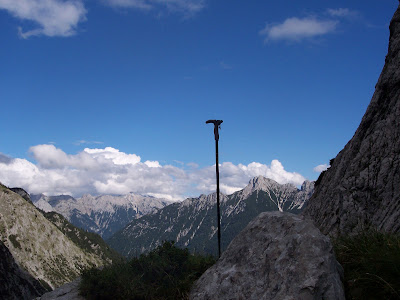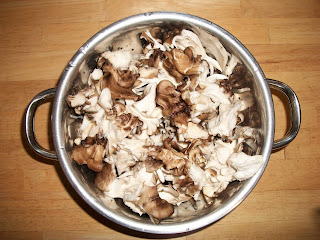[see also Hen of the Woods Mushrooms]

The black trumpets appeared as if out of nowhere. We were not looking for them but, rather, were in pursuit of the more common hen of the woods mushroom.
I don't mind putting off the hen of the woods (aka: maitake) awhile for this new, delicious detour. It is still a bit early for the hen of the woods. Regardless, we went hunting for them this Saturday morning. I had already found the first specimen of the season -- two days prior -- and was overly optimistic about finding another. All of our regular oaks were still empty, unfortunately. Most hen of the woods are still just mycelia, waiting under the ground for just the right moment to show their leafy grey heads.
When I tell people about the mushroom hunting, I usually get some very worried looks. Charles recently admitted to me that he was convinced I'd gone over the cliff the first time I mentioned the idea. That was last fall, in the middle of hen of the woods season. I sold him on it, of course (did I mention that his mother calls me Dr. Death?), and now he is a man possessed. Mushrooms are like that. Once you pass the initial threshold, there really is no going back.
So the two of us were out in the woods, following paths lined with green mossy hummocks and heavy underbrush. The air was cool and smelled like the oak leaves that had fallen the previous year. Last week was rainy and the ground in some places was still damp with the remaining run-off. There were signs of deer, footprints and other spoor, and many colorful mushrooms were thriving in the dampness: their red, purple, white and grey caps popping through the forest floor.
We were visiting one of last year's best maitake oaks. The ground around it was a bare and spongy mat with no trace of the mushrooms that would soon fill the angles between the surface roots. I had almost lost hope when Charles, who had wandered down the slope toward a damp ravine, cried out "Jackpot!"
"Did you find a maitake?" I asked. He was standing in an empty space with no tree roots at all. It was unlikely that he would have found a maitake there.
"No, something even better," he said.
"What is it?" I asked, disappointed. It takes a lot of convincing to get me to try a new mushroom.
"A whole bunch of black trumpets, I think."
 I had heard of the black trumpet, I knew they were related to chanterelles and, as such, would be a great score. I was not, however, equipped to identify these mushrooms.
I had heard of the black trumpet, I knew they were related to chanterelles and, as such, would be a great score. I was not, however, equipped to identify these mushrooms. Approaching carefully, not wanting to crush anything valuable, I scanned the ground for what might be the cone of a trumpet. It was a minute before they came into focus -- they are nearly invisible if you don't know what you are looking for. Then, all of a sudden, the forest floor grew a third dimension. Flower-like funnels, black bouquets, appeared everywhere around his feet.
Charles had an iPhone in his hand and was already scanning through Google images. He handed me the iPhone.
I am not at all careless about mushroom identification. These mushrooms, however, were said to be hard to mistake. Charles had been looking for them for the past three months and was convinced that these were the real thing. I decided to reserve judgment until I could do a bit more research. We would have been foolish, however, to leave the suspects behind so we set about picking them and gently placing them in a cloth shopping bag.
We scanned the vicinity for more of the same and, finding none, took a walk down the path to a similarly marshy area. It was a half-mile walk and completely fruitless. On the path we found ourselves dodging mountain bikers -- painfully shy about our own geeky hobby in the presence of athletes on wheels. After thirty minutes of pointless wanderings, we decided to return to our original hunting ground.
 The decision was well made. Following the marshy ground, we uncovered three more patches of black trumpets before finally calling it a day. The take was well over a pound of mushrooms and, once back at my home computer, I was able to identify them, with unquestionable certainty, as the real mccoy.
The decision was well made. Following the marshy ground, we uncovered three more patches of black trumpets before finally calling it a day. The take was well over a pound of mushrooms and, once back at my home computer, I was able to identify them, with unquestionable certainty, as the real mccoy.The next thing to do was to cook some and see how they tasted. I sauteed a handful -- more than I would have eaten of most new mushrooms -- in butter with salt, basil, oregano and rosemary. The flavor was rich and delicious. The Italian herbs gave them a taste not unlike a pepperoni and mushroom pizza. The mushrooms, themselves, had a buttery, almost fruity smell to them. I have read it described as "apricot" but that does not describe these particular specimens very well. There is a delicate, rich sweetness to the smell, but I would not say apricot.
While waiting to see if I would have any negative reaction to my first dose, I set about processing the majority of my remaining mushrooms. I split them and removed a number of slugs and bugs, the latter of which would invariably make a run for it before succumbing to the butt of my knife on the butcher block.
Next I washed the mushrooms... I know, I know! Washing mushrooms is sacrilege but I just can't leave trails of slug slime on something I intend to eat. There was LOTS of slug slime, and I had seen too many bugs dash out of the trumpets not to think of the bug bits they might have left behind. Others should use their best judgment (and perhaps a nice clean paint brush). I don't advocate washing if your stomach is stronger than mine. I just can't do it, so apologies to the purists of the mushroom world.
I had read that the trumpets dried well. Last fall I dried hen of the woods mushrooms successfully in the oven. For the trumpets, I used a closed oven at 170 degrees, the lowest setting I have on my oven. It took about two hours and was not the perfect solution for the trumpets. There are several things I will do differently next time. First, I might not dry such a large percentage of the haul. Seeing nearly a pound of mushrooms shrink to 1/8 their original size is incredibly disheartening. The resulting cup and a half of dried mushroom dust will go very quickly and does not seem to have the same power of flavor as the original, fresh mushrooms. Second, I will try placing parchment paper under the rack on which I am drying my mushrooms. The mushrooms that fell through the bars became completely adhered to the cookie sheet underneath. This, too, was disheartening -- especially given my diminished stock. Third, I think I may try to dry the mushrooms in a cooler environment -- like a solar dehydrator, perhaps. They seem to have cooked while drying, and this may be the reason that they did not concentrate as much flavor as I had expected.
My second experiment was a black trumpet pizza. I used a red sauce, instead of the white sauce I had seen recommended elsewhere. I also used fewer mushrooms, sprinkling them less liberally than in the pictures I had seen. The result was a fine pizza but there was much less black trumpet flavor than I was expecting. The strength of the red sauce probably masked the trumpets somewhat, and the fact that I did not pile them on was probably a mistake. I will, in the future, use more mushrooms but I have not decided whether or not to use a red sauce. I am not as fond of white pizza.
 For my third experiment, I vacuum sealed a small number of mushrooms and frozen them. This is against the recommendations of many authorities. Most recommend that you sauté your black trumpets and freeze them in a broth. Having successfully frozen hen of the woods mushrooms last year , I wanted to experiment with black trumpets in my new vacuum sealer -- and vacuum sealing broth is impossible of course, not to mention completely unnecessary since you can easily press any air out of the bag before sealing. So I took a handful of fresh trumpets and vacuum sealed them. In the bag they flattened out so much that they looked like a piece of beef jerkey. They then sat in the freezer for a week for the sake of the experiment.
For my third experiment, I vacuum sealed a small number of mushrooms and frozen them. This is against the recommendations of many authorities. Most recommend that you sauté your black trumpets and freeze them in a broth. Having successfully frozen hen of the woods mushrooms last year , I wanted to experiment with black trumpets in my new vacuum sealer -- and vacuum sealing broth is impossible of course, not to mention completely unnecessary since you can easily press any air out of the bag before sealing. So I took a handful of fresh trumpets and vacuum sealed them. In the bag they flattened out so much that they looked like a piece of beef jerkey. They then sat in the freezer for a week for the sake of the experiment.Just tonight, I tossed the same handful of frozen mushrooms into a pan with olive oil, garlic and butter. The sautéed mushrooms had a hint of bitterness that was not there in the original sauté, and were slightly less tender but not offensively so -- really no tougher than sauteed spinach. The taste was still very good to my palate and, for the flexibility I gained by preserving them this way, I will definitely do it again. It will be interesting to see if the bitterness is more or less pronounced in other recipes. Approach this particular method with caution but don't avoid it altogether if you have the luxury of experimentation and an ample supply of mushrooms.
I hope to spend several more days in the woods before the remaining black trumpets succumb to frost. Now that I know where they thrive, I am optimistic that I may find another treasure trove before the season is over.















